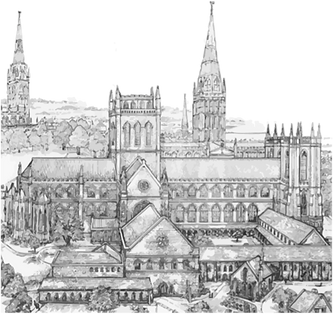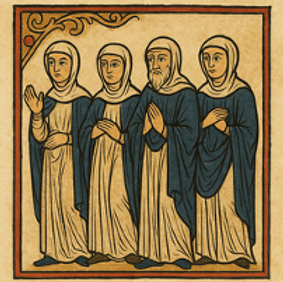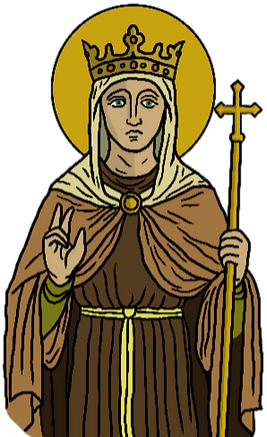The Foundation of St Mary’s Priory, Coventry
From Saxon Nunnery to Benedictine Monastery
The early history of St Mary’s Priory, Coventry, reflects the delicate devotional culture of Anglo-Saxon England, its disruption by Viking incursion, and its eventual transformation under the consolidating authority of the Church. The site’s evolution - from its beginnings as an eighth-century Saxon nunnery, through its destruction in the wars of King Cnut and Eadric Streona, to its re-foundation as a Benedictine monastery by Earl Leofric of Mercia and his wife Godiva - highlights the relationship between devotion, governance, and patronage in shaping monastic life in the Midlands.
The Saxon Nunnery and St Osburga
The earliest recorded foundation at Coventry was a Saxon nunnery, established around c. 700. Tradition associates this house with St Osburga (Osburh/Osburg), described in later sources as an abbess of the community.[i] Although little record of her survives, St Osburga’s memory endured in Coventry. Her name appears in the city’s medieval dedication lists, a sign that the nunnery once held real significance in Mercian religious life.
The existence of the nunnery must be understood in the broader context of Anglo-Saxon Mercia, where female monastic communities flourished under royal and aristocratic patronage in the seventh and eighth centuries. Examples such as Ely under Abbess Æthelthryth and Whitby under Hild demonstrate that women’s houses served as centres of piety.[ii]
Destruction in 1016
By the early eleventh century, the original nunnery appears to have survived in some form until the upheavals of 1016, when the Viking forces of King Cnut and his ally Eadric Streona, ealdorman of Mercia, ravaged Warwickshire. Dugdale’s 17th-century compilation, drawing on earlier traditions, records that “King Canutus of Denmark and that infamous traitor Edricus [Streona] invading Mercia with an army, burnt and wasted divers[e] towns in Warwickshire, which time the said House of Nuns… was destroyed.”[iii] After its destruction, no evidence suggests a rapid rebuilding. The convent disappears from the record until the mid-11th century, when the site re-emerges in a new monastic guise.
Eadric Streona’s involvement is particularly noteworthy. Contemporary sources, such as the Anglo-Saxon Chronicle (MS C, s.a. 1016), portray him as notorious for treachery, changing sides repeatedly during Æthelred’s and Edmund Ironside’s struggles against Cnut. [iv] His participation in the devastation of Coventry reinforces his reputation as a destabilising figure, whose opportunism contributed to the political chaos of the period. His eventual execution at Cnut’s command in the same year illustrates the ruthless consolidation of power that followed.
The Benedictine Foundation of 1043
The ruined site lay dormant until 1043, when Earl Leofric of Mercia and his wife Godiva founded a Benedictine monastery on the same ground. The act was not simply restorative but transformative, the replacement of a female religious community with a male Benedictine priory reflects wider ecclesiastical trends in late Anglo-Saxon England, where aristocratic patronage increasingly favoured the Benedictine reform movement associated with places such as Winchester and Ramsey.[v]
The new monastery was consecrated on 4 October 1043 by Archbishop Eadsige of Canterbury, with Archbishop Ælfric of York and five bishops in attendance.[vi] Its dedication was multi-layered; to St Mary, St Peter, St Osburh, and All Saints. This choice reveals deliberate continuity with the earlier foundation, acknowledging Osburga as a local saint while situating the house within the universal traditions of Marian and Petrine devotion.
The scale of Leofric and Godiva’s endowment was remarkable. The original endowment by Leofric, consisted of a half of Coventry with fifteen lordships in Warwickshire and nine in other counties, making it (says Roger de Hoveden) the wealthiest monastery of the period.[vii] According to the Chronicon ex Chronicis of John of Worcester, “he and his wife… built the monastery there from the foundations… and made it so rich in various ornaments that in no monastery in England might be found the abundance of gold, silver, gems and precious stones that was at that time in its possession.”[viii] Leofric granted the northern half of Coventry to the priory, thereafter termed the “Prior’s Half,” while retaining the “Earl’s Half” for his heirs.[ix]
Godiva’s personal contribution is repeatedly emphasised in the sources. Dugdale, citing earlier chronicles, notes that she “gave her whole treasure thereto, and sent for skilful goldsmiths; who, with all the Gold and Silver she had, made Crosses, Images of Saints, and other curious ornaments.”[x] Relics, too, were furnished, including the arm of St Augustine of Hippo, housed in a silver shrine, thus linking the new house to the universal Church.[xi]
The first abbot, Leofwine, presided over a community of twenty-four monks. Such a foundation positioned Coventry among the significant Benedictine houses of England, its resources ensuring both spiritual prestige and temporal influence in the region.
Legacy
The transition from Saxon nunnery to Benedictine priory marked an overwhelming change. Female communities, often vulnerable and less well-endowed, gave way to male Benedictine houses aligned with reform and aristocratic patronage. Leofric and Godiva’s endowment was both devotion and a statement of Mercian authority under Edward the Confessor. Yet the survival of St Osburga in the priory’s dedication shows how older sanctity was absorbed to legitimise the new foundation.
[i] Dugdale, W. (1656). The antiquities of Warwickshire illustrated (p. 116). London.
[ii] Blair, J. (2005). The church in Anglo-Saxon society (p. 252–256). Oxford University Press.
[iii] Dugdale, W. (1656). The antiquities of Warwickshire illustrated (p. 85). London.
[iv] The Anglo-Saxon chronicle (MS C). (n.d.). 1016
[v] Knowles, D. (1940). The monastic order in England (pp. 39–45). Cambridge University Press.
[vi] Page, W. (Ed.). (1908). Houses of Benedictine monks: Priory of Coventry. In A history of the county of Warwick (Vol. 2, pp. 52–59). Victoria County History. British History Online.
[vii] Woodhouse, F. W. (1909). The churches of Coventry: A short history of the city & its medieval remains (p. 4). George Bell & Sons.
[viii] Darlington, R. R., & McGurk, P. (Eds.). (1995). John of Worcester: Chronicon ex chronicis (p. 583). Clarendon Press.
[ix] Victoria County History of Warwickshire. (1908). A history of the county of Warwick (Vol. 2, p. 52). Victoria County History.
[x] Dugdale, W. (1656). The antiquities of Warwickshire illustrated (p. 86). London.
[xi] Victoria County History of Warwickshire. (1908). A history of the county of Warwick (Vol. 2, p. 53). Victoria County History.
Dugdale, W. (1656). The antiquities of Warwickshire illustrated (p. 100). London.




